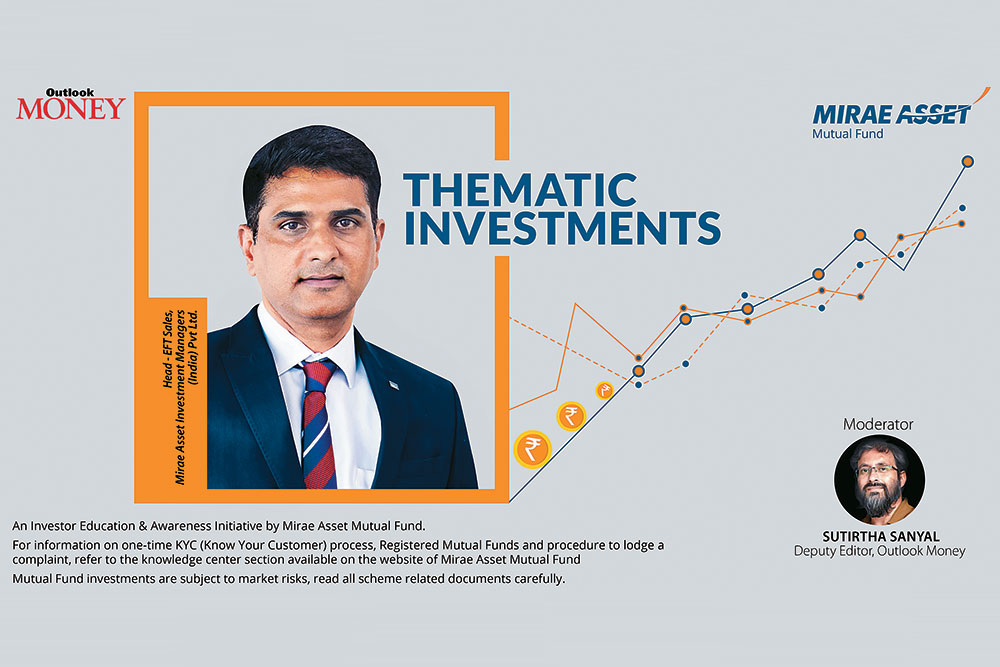Thematic funds have gained the attention of investors, of late. Amid the volatility in the stock market, the emerging trends in certain mega trends around electric vehicles, artificial intelligence have found favour with investors keen to explore these emerging futuristic themes. A recent discussion with Umesh Kumar Dalia, Head – ETF Sales, Mirae Asset Investment Managers (India) Pvt. Ltd as part of Outlook Money’s ‘Investment Made Easy’ webinar series threw some light on the strategy one should adopt for investing in thematic funds. Dalia was in conversation with Sutirtha Sanyal, Assistant Editor, Outlook Money.
Here are some edited excerpts from the discussion
What is thematic investing?
Themes have become popular with evolved investors, who have started moving towards themes in view of the advantages they offer. But before we delve into thematic investing, we need to understand the concept of theme. Thematic investing can be defined as a type of investing strategy where you identify broad-based macro level trends in the economy as well as the businesses that would benefit from such trends. It basically allows investors to get returns through potential opportunities created by economic, technological or other changes. Basically, it is a top-down approach that identifies themes and invests across businesses that represent that particular theme. Thematic funds capture the entire ecosystem starting from the beginning till the end. For instance, if we talk of EV as a theme, then it would typically capture the entire ecosystem from mining till the distribution network in the showroom.
If we talk of manufacturing as a theme, then it would ideally cover all industries that are into manufacturing, such as auto, pharma, chemical, cement, steel, and so on.
The beauty of thematic investing is that it gives exposure to all the companies and business involved in the entire ecosystem that make up the theme.
How have thematic funds grown in India and globally?
Globally, there are more than 12,000 thematic funds. The total assets under management (AUM) they have is close to $241 billion from 254 product manufacturers across 47 exchanges across 31 countries. So, it is not restricted to one country or region, but is actually a global phenomenon.
As for India, till July 2022, 11 new products have been launched in the last one year, and the AUM of current inflows in last one year is more than Rs 2,700 crore.
So, in India also, investors are gravitating towards these as they offer some merit which are not available otherwise.
How are thematic funds different from sectoral funds?
The basic difference lies in their investment strategy. A thematic fund invests in a broad theme that cuts across multiple sectors. For instance, if we talk of financial services as a theme, it would include banks, insurance companies, as well as stock exchanges. But if we talk of banking fund, which is a sectoral fund, then there could be private as well as public sector banks.
Do passive products give better exposure to thematic investing?
By nature, passive funds are cost effective than actively-managed funds. For thematic funds too, passive funds would be a low-cost way to invest in promising themes, such as manufacturing, construction, ESG, and so on.
Many investors might have concern over the volatile market situation. In such situations, where the investors might be a bit confused, indexing can be a good solution, as it has a pre-defined structure.
What is the usual return expectation from various themes?
It’s important to understand the risk return. For instance, a thematic fund based on ESG might have less volatility whereas something like robotic, which is expected to scale up in future, and might possibly generate higher return as well, but could be more volatile. So, every fund has a different risk profile, and investors should choose them keeping in mind his/her own risk profile. For instance, if you go for a futuristic theme, you might have to stay invested for a longer time period.
What should be the ideal allocation?
Based on the investment objective and the conviction one has in a particular theme, one should ideally choose between short-term tactical as well as long-term strategic allocation. A long-term call will help them patiently ride out the investment cycle of that particular theme. Since they have a higher risk also, so compared to broad based indices, an investor can consider allocating 10-15 per cent to these thematic products. If one follows a core-and-satellite investment strategy, then thematic funds can be the satellite portfolio while broad-based indices can form the core portfolio.
Disclaimer
An Investor Education & Awareness Initiative by Mirae Asset Mutual Fund.
For information on one-time KYC (Know Your Customer) process, Registered Mutual Funds and procedure to lodge a complaint, refer to the knowledge center section available on the website of Mirae Asset Mutual Fund
Mutual Fund investments are subject to market risks, read all scheme related documents carefully.

